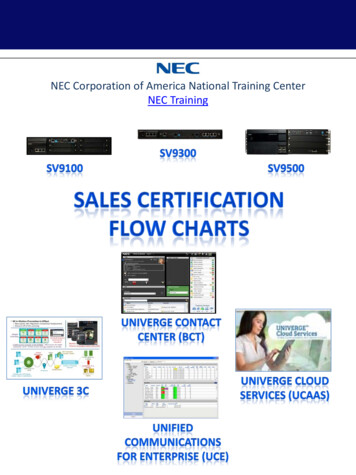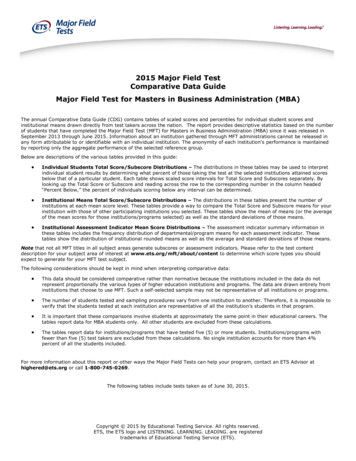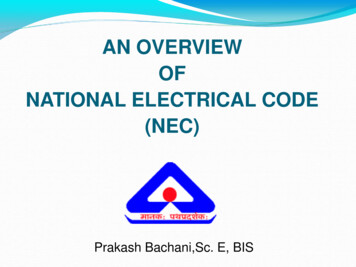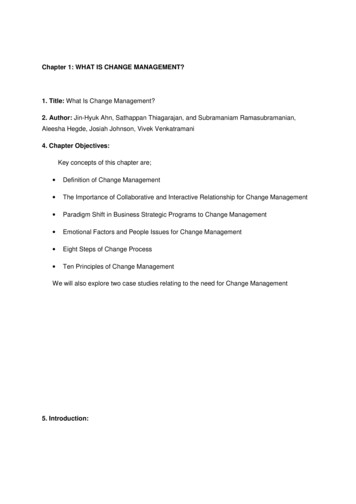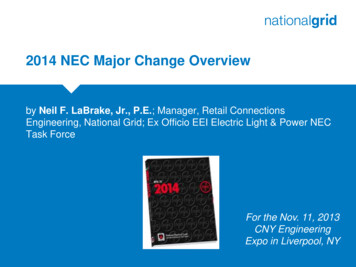
Transcription
2014 NEC Major Change Overviewby Neil F. LaBrake, Jr., P.E.; Manager, Retail ConnectionsEngineering, National Grid; Ex Officio EEI Electric Light & Power NECTask ForceFor the Nov. 11, 2013CNY EngineeringExpo in Liverpool, NY
Presenter:Neil F. LaBrake, Jr., P.E. Experienced since 1981 as an electrical engineer with an upstate New Yorkutility (previous Niagara Mohawk, now National Grid) in generation,distribution, transmission, and substation design. Six years of experience inelectrical design for an operating nuclear power plant and experience since1987 in utility electric service requirements, procedures and methods. Presently the Manager of Retail Connections Engineering directingengineering studies, installation acceptance review, and complianceverification of complex distributed generation (DG) facilities integrated toNational Grid’s electric power system (EPS) in NY, MA, and RI from receiptof complete application to energization. Since 1995, direct involvement in national codes: National Grid’srepresentative to Edison Electric Institute serving as the Chair from 20012008 to the EEI/Electric Light & Power NEC Task Force. Served on NationalElectrical Code (NEC) Panels 3 and 20, special NEC task groups, and onNational Electrical Safety Code (NESC) Subcommittee 4. EEI'srepresentative to the NEC-NESC Ad Hoc since 2008. Presently the EEIPrincipal Representative on both the NEC Code-making Panel 1 and theNEC Correlating Committee. Presently on the Executive Board of the Empire Chapter IAEI. Past Boardmember of the Technology Alliance of Central New York 2002-2012. Chairedthe NYS Electric Service Committee 1995-1996 and 2007-2008. An2IEEE/Power Engineering Society member.
Objectives NEC Overview Purpose of the NEC NEC Code Arrangement & Related Publications NFPA’s NEC Publication and Process Highlights of Major Changes in the 2014 NEC Code-wide Chapters 1-8 Major Highlights Chapter 6 DG Related Highlights Informative Annexes Where to Get More Information Public Input for 2017 NEC3
Purpose of NFPA 70 - theNational Electrical Code (NEC)The 1897 Edition was thefirst edition of the NEC! What is NFPA 70?“Model Document Suitable for Adoption by Law”The NEC is the benchmark for safe electrical design, installation, andinspection to protect people and property from electrical hazards. What does NFPA 70 address?“ANSI Standard on the Safe Installation of Electrical Systems by theNational Fire Protection Association”The NEC addresses the installation of electrical conductors,equipment, and raceways; signaling and communications conductors,equipment, and raceways; and optical fiber cables and raceways in4commercial, residential, and industrial occupancies.
NEC Code Arrangement &Related Publications –What is the structure of the NEC? Chapters Articles Parts Sections Levels & List Items Informational Annexes 1M Manual of Style NEC Style ManualThe NEC is not a DesignSpecification or an InstructionManual for Untrained Persons!5
NEC Code Arrangement &Related Publications –Are there other documents like the NEC? User Codes IEC 60364 - Electrical Installations of Buildings Canadian Electrical Code Part I Supply Codes National Electrical Safety Code (NESC) Electrical Equipment Maintenance (NFPA 70B, NETA-MTS) Electrical Safety in the Workplace (NFPA 70E)6
NEC Code Arrangement &Related Publications –Supply vs. Utilization Codes Supply Code User Code National Electrical SafetyCode (NESC) National Electrical Code (NEC)Service PointThe utility’s rules typically do not exceed the National Rules**Except for local specific requirements**7
NFPA’s NEC Publicationand ProcessNFPA’s 6 Steps:1. Public Input5.2. First Draft Report NFPA Technical Committees: NEC Code-Making Panels(CMP) NEC Correlating Committee(CC) Issue First Draft Report andCall for CommentsTechnical Committee ReportSession NITMAM Annual Meeting of the NFPA 6.Standards Council Issuance NFPA Technical Committees:CMP followed by CC Issue Second Draft Report andCall for Intent to Make a MotionAppeals Hearings 3. Public Comment4. Second Draft ReportAdoption of theAmended Document Standards CouncilDisposition of AppealsDocument IssuanceThe NEC is on a 3-year cycle.8
Highlights of Major Changes in the 2014 NEC
2014 NECAdoption The 2014 National Electrical Code (NEC) was officially adoptedby the National Fire Protection Association (NFPA) generalmembership on June 13th, 2013 at the NFPA Annual Meeting inChicago, IL and issued by the Standards Council on August 1st,2013, effective August 21st, 2013 concluding the 3-year cycle. There were 3,745 Proposals and 1,625 Public Comments forthe 2014 NEC – supporting utTheCodes/70/70-A2013-ROCErrata odes/70/70-A2013-ROCErrata 2-82 2-84 16-37 odes/70/A2013 FloorAction final.pdf10
2014 NECCode-wide Changes 4 new articles added: 393 Low-Voltage Suspended Ceiling Power DistributionSystems 646 Modular Data Centers 728 Fire Resistive Cable Systems 750 Energy Management Systems Code-wide changes: Requirements for DC systems Changing voltage threshold of 600 volts to 1000 volts More prescriptive requirements for markings11
2014 NECHighlights of Major Changes – Chapter 1 90.1 Purpose was clarified about the intention 100.Control Circuit covers the previous similar definitions of 409.2 ControlCircuit, 430.2 Motor Control Circuit, and 522.2 Control circuit 100.Coordination (Selective) revised for clarity and distinguish“coordination” from “selective coordination” for over limited ranges versusover complete ranges of available overcurrents and the times associated 100.Effective Ground-Fault Current Path relocated from 250.2 since it isused in many articles of the NEC 100.Premises Wiring (System) has an Informational Note added to provideexamples of power sources 100.Accessible, Readily was revised to prohibit “the use of tools” whenequipment is required to have ready access 100.Separately Derived System clarified grounding and bondingconnections from sources 100.Substation relocated from 225.2 since it applies to more than outsidebranch circuits and feeders and is used elsewhere in the NEC12
2014 NECHighlights of Major Changes – Chapter 1 (cont’d) 110.21(B) adds specific requirements for field applied hazard warning labelsand similar markings where required or specified elsewhere in the NEC 110.24(A) IN new informational note clarifies that the available fault currentmarkings are for short circuit ratings and equipment rating purposes under theNEC and not for arc flash hazard analysis required in NFPA 70E 110.25 "Lockable Disconnecting Means" is provided for consistentrequirements throughout the NEC 110.26(C)(3) revised lowering equipment size to 800A where personnel doorsand listed panic hardware are required for safe egress 110.26(E)(2)(a)&(b) adds new requirement for dedicated equipment space atoutdoor installations correlating with existing indoor provisions in110.26(E)(1)(a) 110.27(A)(4) revised to increase elevation of live parts against accidentalcontact to 8-1/2 ft. for voltages 301 to 600V above the floor or working surface– corresponds with the NESC 124A3 and Table 124-113
2014 NECHighlights of Major Changes – Chapter 2 GFCI protection in branch circuits’ requirements changed in 210.8(A), -(7),-(9), -(10) and 210.8(B)(8) and 210.8(D) 210.12 requires AFCI devices to be readily accessible 210.12(B) revised to allow up to 6 ft. extension of branch circuits withoutAFCI protection – See also 406.4(D) on replacements 210.13 is new ground fault protection for branch circuits’ equipment whichis the same as for feeders (Article 215) and services (Article 230) 210.17 adds branch circuit requirements for electric vehicle (EV) charging 210.64 adds new requirement for 125V, 15A or 20A receptacle in electricservice areas within 50 ft. except for 1 & 2 family dwellings 225.52(A) revised location requirements for 1kV disconnect means 230.30 revised to include list of acceptable wiring methods forunderground services 230.82(3) adds label requirement to the meter disconnect14
2014 NECHighlights of Major Changes – Chapter 2 (cont’d) 240.87 arc energy reduction requirements revised to allow 1200A circuitbreakers to be adjusted to protect workers and reduce arc flash injuries 250.64(D)(1) revised for common Grounding Electrode Conductor andTaps to address bus bar connections 250.66 & .68 have clarifications made to grounding electrode connections Table 250.102(C) is new adding sizing of grounded conductors, mainbonding jumpers, system bonding jumpers, and supply side bondingjumpers 250.166 adds max. size grounding electrode conductor for DC systems 250.167 adds ground fault detection on DC systems 250.186 is a new requirement for services over 1kV to have supply sidebonding jumper brought to the service equipment 250.194 adds requirements for bonding and grounding metal fences andstructures around substations15
2014 NECHighlights of Major Changes – Chapter 3 300.38 new requirement for raceways in wet locations above grade 1kV 310.15 has changes to tables in subparts (B)(3)(a) and (B)(3)(c) andremoved Table 310.15(B)(7) which requires the user to size 100A to 400Aservice conductors and the main power feeder for dwellings according to acalculation – an IN references new Example D7 in Informational Annex D 314.15 added requirements for outlet box hoods and weep holes for boxesin damp or wet locations 330.30(B) modified the securing requirements for MC cable not to exceed10 ft. 376.56(B)(1) and (B)(5) requires power distribution blocks be listed forpurpose where used on line side of service equipment – Listings need tobe checked as the devices may be limited to 10kAIC 392.20(A) and (B) revised to clarify cables installed in cable trays to bebased on operating voltage rather than the cable rating16
2014 NECHighlights of Major Changes – Chapter 4 408.4(B) requires switchgear, switchboards, and panelboards having morethan 1 source of power to be marked indicating where all sources originate 408.55 adds provisions for minimum required wire bending space forconductors entering the enclosure from the rear similar to that of pull orjunction boxes in 314.28(A)(2) GFCI protection is extended to 422.23 Automotive Vacuum Machines,422.49 High Pressure Spray Washers, 422.51 Vending Machines, and445.20 15kW or smaller Portable Generators 450.10(A) revision does not permit grounding and bonding terminal bar tobe installed on or over vent screen portion of dry type transformerenclosure 490.48(B) covers requirements for substations relocated from 225.70 inthe 2011 NEC – See 2014 NEC Errata for corrections to text17
2014 NECHighlights of Major Changes – Chapter 5 517.18(A) requires coverplate for receptacles on critical branch to havedistinctive color or marking 517.30(G) revised “Coordination (Essential Electrical System)” forcoordination of faults that exceed 0.1 seconds – correlates with NFPA 992012 547.2 clarifies the “Equipotential Plane” definition that it intends on“minimizing” voltage potentials 551.71 requires every recreational vehicle site with a 50A receptacle to beequipped with a 30A receptacle as well as the minimum one 20A 125Vreceptacle requirement 590.4(J) prohibits cable assemblies and flexible cords and cables asbranch circuits and feeders from being installed on the floor or groundexcept extension cords – this is an OSHA requirement18
2014 NECHighlights of Major Changes – Chapter 6 600.6(A)(1) requires disconnect means at the sign’s supply wiring point ofentry to its enclosure 645.27 new requirement for all critical operations data systems’overcurrent devices to be selectively coordinated with all supply sideovercurrent devices 680.22(B)(6) adds permission to install specific low voltage luminaireswithin 5 ft. of inside walls of permanent pools 680.26(C) clarifies requirement for “bonding” of pool water 680.42(B) adds 4 specific conditions to meet for equipotential bonding ofperimeter services for spas and hot tubs19
2014 NECHighlights of Major Changes – Chapter 6 (DG Topics) 690.12 has new provisions for rapid shutdown of PV systems onbuildings when utility supply is de-energized within 10 seconds – thisoriginated from First Responders 690.35 requires ground fault protection for ungrounded PV DC systemsto be listed 690.47(D) clarifies ground- and pole- mounted PV arrays require agrounding electrode system 690.81 is a new listing requirement for PV wire used in systems over600 V not exceeding 2 kV Article 694 revised to apply to wind electric systems regardless of size– previously it applied to 100 kW and less20
2014 NECHighlights of Major Changes – Chapters 7 & 8 700.8 requires listed surge protective devices (SPD) for emergencysystems switchboards and panelboards 700.24 new requirement for emergency luminaires and external bypasscontrols to be individually listed for use in emergency systems whereillumination is provided by one or more directly controlled luminaires 700.27 requires a licensed professional engineer or other qualified personto design the selective coordination 702.7(C) requires warning sign placed near optional standby systempower inlet for temporary connection to a portable generator 708.52(D) requires separation of ground fault protection time-overcurrentcharacteristics to conform to manufacturer’s recommendations for COPSequipment 770.180 adds grounding devices used for optical fiber cables 800.12 adds new provision and definition in 800.2 for “Innerduct” 810.6 requires antenna lead-in surge protectors be listed21 pa
10 2014 NEC Adoption The 2014 National Electrical Code (NEC) was officially adopted by the National Fire Protection Association (NFPA) general membership on June 13th, 2013 at the NFPA Annual Meeting in Chicago, IL and issued by the Standards Council on August 1st, 2013, effective August 21st, 2013 concluding the 3-year cycle. There were 3,745 Proposals and 1,625 Public Comments for
